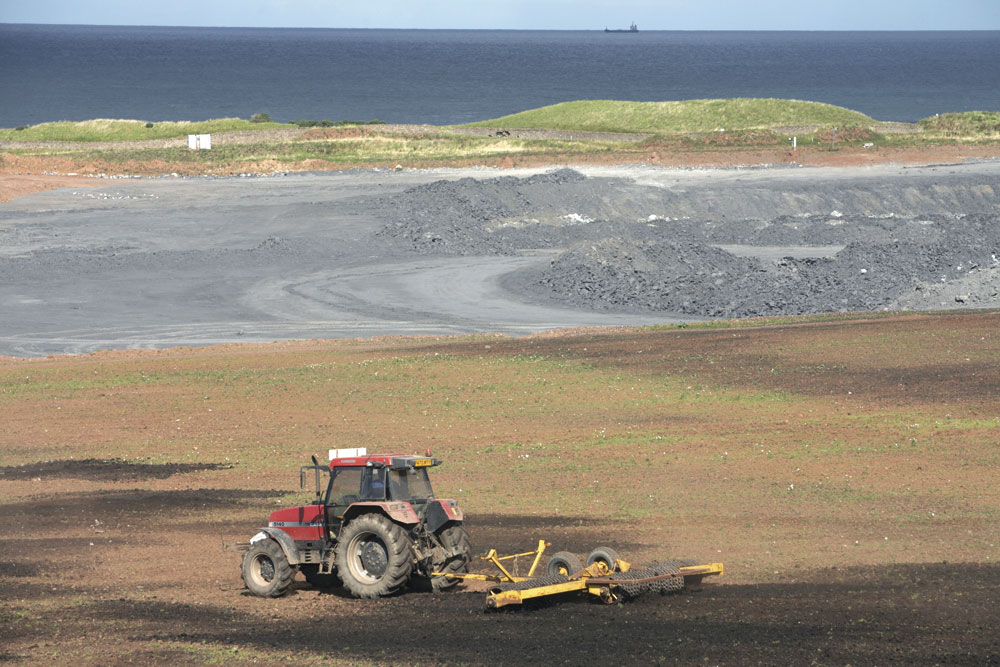Trailblazing Success For Dunbar

Progressive quarry restoration reduces the amount of land under extraction and allows for the long-term establishment of native woodlands and grasslands. But poor-quality soil can render restoration a challenge. Paul Mathers, programme manager for landscape & regeneration at WRAP (Waste & Resources Action Programme), explains how a groundbreaking trial used quality compost to transform a major Scottish quarry.
According to the British Aggregates Association (BAA), over a third of all national Sites of Special Scientific Interest (SSSI) are restored quarries where native animal and plant life are thriving. Many of these sites are now open to the public and not only provide areas of outstanding natural beauty, but also sites of education for local communities. Site restoration is, therefore, vitally important, and is in many ways the ultimate form of recycling – transforming derelict land back into a natural habitat.
Safeguarding the future of previously quarried land by ensuring its return to nature is the strategy employed by Lafarge Cement at Dunbar Works in East Lothian, Scotland. The quarry is responsible for the production of over 1 million tonnes of cement each year for construction projects across Scotland and the north of England, and in doing so, generates 3 million tonnes of excavation material. An opencast strip-mining technique is employed, which involves moving from east to west in 30m wide strips measuring 800–900m in length. This generates a significant amount of space, as well as a large volume of material, so restoration is a practical solution for reducing and reusing the excavation material.
A progressive land restoration strategy was already in place at Dunbar, but the natural topsoils used in this process were sandy, stony and nutrient poor, making it difficult for vegetation to establish and thrive. This did, however, make the site an ideal location to investigate the benefits of mixing quality compost with the existing poor-quality soils to improve their condition. The aim was to produce a high-quality topsoil that could support the establishment of healthy woodland, grassland, and rough grazing for agricultural purposes, as well as to prevent erosion on slopes.
For the purpose of the WRAP-backed trial, Dunbar Works imported 2,300 tonnes of BSI PAS 100 compost from Scottish Water Waste Services in Deerdykes, Glasgow, and involved Scottish Agricultural College (SAC) as scientific advisors. The BSI PAS 100 specification ensures that compost manufactured to these high standards is safe, reliable and consistent, so users can have complete confidence in its quality.
The compost was trialled in three key areas: the growth of ground vegetation; the growth of ryegrass swards; and the growth of young saplings. In each case, Lafarge Cement tested a variety of compost/soil mixtures to create a suitable growing medium and compared the results to growth on non-amended areas.
Early results were extremely encouraging. The establishment of natural vegetation in amenity grassland was significantly faster on compost-amended soils than on the non-amended equivalent, especially when a compost-to-soil mixture of 1:10 by volume was used. Similarly, the establishment of ryegrass and young tree saplings in compost-amended soils eclipsed their non-amended counterparts. For ryegrass, the most effective mix saw compost added to the soil at 1:4 by volume, while for the young trees, compost was incorporated at 1:10 by volume, but to a depth of 40cm to help support root growth.
The quality compost improves the soil in a number of ways. It contains a range of essential nutrients and minerals (such as nitrogen and potassium) that have been proven to significantly boost vegetation establishment and growth. In the Dunbar trial, there was also some evidence that it had improved the physical properties of the soil, allowing greater absorption of water during periods of sustained rainfall, and reducing the damaging effects of run-off.
It is clear that BSI PAS 100 compost is a material with huge potential for use in the restoration of UK quarries. Moreover, it is consistent, fit for purpose and readily available.
Lafarge Cement’s national minerals manager, Jeremy Elvins, who regards quality compost as an ideal restoration material, summed up the range of benefits brought to Dunbar Works through the specification of quality compost: ‘We were interested in taking part in the project as we had a shortage of topsoil, and quality compost appeared to be the best form of organic matter to use for replicating natural topsoil conditions, both physically and nutrient-wise. We also needed to ensure that the compost blends did not produce any unacceptable leachate, so by using a fully tested and approved material we were assured of this.’
For more information on the Dunbar trial, and how to specify and use BSI PAS 100 compost, visit www.wrap.org.uk/composting or call Paul Mathers on tel: (01295) 817879.


